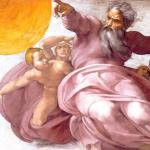A little over a year ago, I wrote the following in a post reflecting on the Hebrew term tabnit, used in Exodus and Chronicles to describe the heavenly “pattern” of the sanctuary:
“Deuteronomy 4:16-18 uses the word five times, not of a ‘model’ or ‘plan’ but of likenesses made according to a plan or model. Yahweh prohibits Israel from making and venerating a tabnit of male or female, animals, birds, creeping things, or fish (note the Genesis 1 classification of creatures). Here the living creature – the woman or the calf or the snake – is the model, and the graven-thing is the likeness of the model. The word tabnit is used for the copy rather than the original (cf. the similar use in Psalm 106:20; Isaiah 44:13; Ezekiel 8:10).”
Looking back at Deuteronomy and the other passages I cited, I’m not sure I got it right.
The Hebrew in Deuteronomy 4:16-18 appears repetitive. After reminding Israel that they saw no form or likeness (temunah) on Sinai, Moses warns them not to “act corruptly” by making a graven image (pesel) of any likeness (temunah). A pesel of a temunah is presumably a carved-image made to resemble the form of God, a form that was not seen.
But temunah is in the construct (temunat) and is followed by the phrase kal-samel. The pesel in view is the form/likeness of any semel, a word typically translated as “idol” (2 Chronicles 33:7, 15; Ezekiel 8:3, 5) but in the NASB of Deuteronomy 4 translated as “figure.” Thus: Do not make a graven-image of a form/likeness of any figure.
That’s already a mouthful and we haven’t gotten to tabnit yet. That comes in the phrases that follow. Moses forbids Israel to make a pesel of any temunah of a semel, and spells that out with five phrases that all begin with tabnit: no tabnit of male or female, earth-animal, sky-flier, ground-creeper, or fish (note that the list reverses the order of Genesis 1).
Two questions: How is tabnit related to the other terms? And, how is tabnit related grammatically to the previous phrases?
To take the second question first: The tabnit phrases seem to be epexegetical of “any figure” that precedes it. That is, Moses warns them against making any carved image of any likeness of a figure, whether that is human, animal, bird, crawler, or fish. It’s an expansion of the Second Word’s prohibition of peselim of things in heaven, earth, or the waters.
That grammatical point is one reason, perhaps, that the NASB translated use “likeness” for tabnit. On that translation, my earlier comment is accurate: tabnit here refers not to model but to a copy.
But the grammatical point isn’t decisive. We can try out translating tabnit in the same way it’s used in the tabernacle and temple texts: Do not make a pesel of any form of a figure, a pattern of male or female, animal, bird, etc.
On that reading, the logic might be: You saw no tabnit on the mountain, no original form according to which you might make a pesel. Don’t act corruptly and make a tabnit-model for yourself; since you didn’t see God, don’t presume to make your own archetype.
That’s not as elegant as I’d like, but it opens up a fresh perspective on idolatry. Idols aren’t merely temunot – likenesses; they are intended to be, and function as tabnitim.
An idol-maker may intend to represent a god by carving the pesel. What he actually produces is something more dynamic, and so more dangerous; his pesel forms a model according to which viewers are made and re-made. Idols are patterns for their worshipers.
There is a heavenly pattern, disclosed to prophets like Moses, David, Ezekiel, John. We rightly build according to those patterns that are brought down from the mountain – Sinai, Zion, new Jerusalem.
To make our own patterns, and to build according to what we have imagined in our heads, is deadly – deadly not because our graven-patterns don’t work, but because they work all too well, forming people and societies into their image. As the Psalmist says, “Everyone who worships them shall become like them.”












